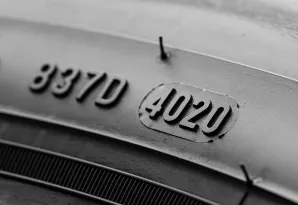I've turned to used tires many times over the years to sample a variety of compounds and tread patterns more affordably. Done right, the savings can be massive while still ensuring proper performance and safety. But there are some crucial factors to keep in mind when scouring for quality used tires. Allow me to share my detailed guidelines.

Table of Contents
Evaluating Tread Depth
The first step in assessing the condition of a used tire is to measure its tread depth. A new tire typically has between 10/32" and 12/32" of tread depth, but once it reaches 4/32" or less, it's generally considered unsafe and in need of replacement.
To check the tread depth, you can use a dedicated tread depth gauge, which is an inexpensive tool that's well worth the investment if you plan on buying used tires regularly. Alternatively, you can perform the classic "penny test" – insert a penny into the tread groove with Lincoln's head facing down. If you can see the entire head, it means the tread depth is below 4/32" and the tire should be replaced.

Keep in mind that when you factor in the cost of mounting, balancing, and installing a used tire (typically $80 to $120), it may not be worth purchasing a tire with extremely low tread depth, as it won't last very long before needing to be replaced again.
A good rule of thumb is to aim for tires with at least 50% of their original tread depth remaining. This way, you can negotiate a fair price that reflects the remaining tread life while still getting a reasonable amount of usage out of the tires before they need to be replaced.
Checking Tire Age
In addition to tread depth, it's crucial to consider the age of the tire you're interested in purchasing. Even if a tire appears to have plenty of tread left, if it's too old, it can be prone to cracking, dry rot, and potential blowouts due to the breakdown of the rubber compound over time.
According to most automotive associations, tires should be replaced every five to six years, regardless of the remaining tread depth. This is because exposure to sunlight, heat, and various weather conditions can cause the rubber to degrade and become brittle, compromising the tire's structural integrity and performance.
To determine a tire's age, look for the DOT code on the sidewall. This code consists of a combination of numbers and letters, with the last four digits representing the week and year of manufacture. For example, if the code ends with 4020, it means the tire was produced in the 40th week of 2020.

As a general rule of thumb, I avoid purchasing any tires older than five years, even if they appear to be in good condition. It's simply not worth the risk of a potential blowout or premature failure.
Inspecting for Defects and Damage
Once you've determined that a used tire has sufficient tread depth and is not too old, the next step is to thoroughly inspect it for any defects or signs of damage. Here are some key things to look out for:
- Bubbles or bulges in the sidewall: These can indicate structural weaknesses and make the tire prone to blowouts.
- Cracks or dry rot: Look for hairline cracks or signs of dryness and brittleness, especially in the sidewall area.
- Patches or plugs: While minor repairs like these may be acceptable, it's generally better to avoid tires that have been patched or plugged, as they may have underlying issues.
- Missing chunks or holes: Any significant missing pieces of rubber or holes in the tread or sidewall are cause for concern and should be avoided.
If you notice any of these defects, it's best to steer clear of that particular tire. While you may be able to negotiate a lower price or request a warranty from the seller, it's generally not worth the risk of a potential failure on the road.
Understanding Treadwear Ratings (UTQG)
Another important factor to consider when buying used tires is the Uniform Tire Quality Grade (UTQG) rating. This rating, typically found on the tire's sidewall, provides an indication of the tire's expected treadwear performance and durability. It's important to note that the UTQG rating is a manufacturer-provided estimate and may not always be an accurate representation of real-world performance. Additionally, the rating does not account for factors such as your driving style, vehicle weight, and road conditions, which can all impact treadwear.
The UTQG has three components:
- Treadwear
- Traction
- Temperature
| UTQG Component | Rating | Explanation |
|---|---|---|
| Treadwear | 100-300 | Short tread life, high grip (performance) |
| 400-600+ | Long tread life, lower grip (durability) | |
| Traction | AA | Best wet traction |
| A | - | |
| B | - | |
| C | Lowest wet traction | |
| Temperature | A | Best heat resistance at high speeds |
| B | - | |
| C | Lowest heat resistance |
The treadwear rating is the first number and indicates the tire's expected lifespan compared to a reference tire graded 100. Higher numbers mean longer tread life. On the softer, stickier end, ratings in the 100-300 range indicate short treadlife but serious grip for performance driving. Up in the 400-600+ range, you'll find harder compounds built for durability over outright grip.
The traction rating is the second letter (AA, A, B, C) and measures the tire's stopping ability on wet surfaces, with AA being the best.
The temperature rating is the last letter (A, B, C) and indicates the tire's heat resistance at speed, with A being the highest rating.
When shopping for used tires, consider the UTQG rating in conjunction with the remaining tread depth and age of the tire. A tire with a higher UTQG rating and sufficient tread depth may be a better long-term investment, even if it costs slightly more upfront.
Researching Brand, Model, and Reviews
Before making a purchase, it's also a good idea to research the specific brand and model of the used tires you're considering. Look up the original retail price to get an idea of how much you should be paying for a used version, and read through customer reviews and ratings to get a sense of the tire's overall performance and durability.
Websites like TireRack.com are excellent resources for researching tires, as they provide detailed specifications, reviews, and pricing information. You can use this information to gauge whether the asking price for a set of used tires is reasonable or if you should negotiate further.
Examining for Uneven Wear
When inspecting a set of used tires, it's essential to look for signs of uneven tread wear. Uneven wear can be caused by a variety of factors, such as improper inflation, misalignment, or suspension issues, and it can lead to premature tire failure and compromised handling and performance.
Ideally, you want to find a set of tires that have worn evenly across the tread surface. If you notice excessive wear on the inner or outer edges, or if one tire in the set appears significantly more worn than the others, it's a sign that there may be underlying issues with the vehicle's alignment or suspension.
Purchasing a set of unevenly worn tires can not only create safety concerns but can also lead to further issues down the road, as the tires will continue to wear unevenly even after being properly aligned and balanced.
Negotiating and Purchasing
Once you've thoroughly inspected a set of used tires and determined that they meet your criteria for tread depth, age, condition, and wear, it's time to negotiate the price. Here are some tips for getting the best deal:
- Research the going rates for similar used tires in your area, either through online classifieds or by visiting local tire shops.
- Make a reasonable offer based on the tire's condition, age, and remaining tread depth. As a general rule, aim for 50% or less of the original retail price for a tire with around 50% tread depth remaining.
- Point out any defects or concerns you've noticed, such as uneven wear or minor damage, and use these as bargaining chips to negotiate a lower price.
- Be prepared to walk away if the seller is unwilling to budge on an unreasonable asking price. There are always other deals to be found.
- Ask about warranties or guarantees, especially if the tires have any visible defects or repairs.
Remember, the key to successful negotiation is to remain firm but fair. Sellers of used tires are often eager to move their inventory and may be willing to accept a reasonable offer